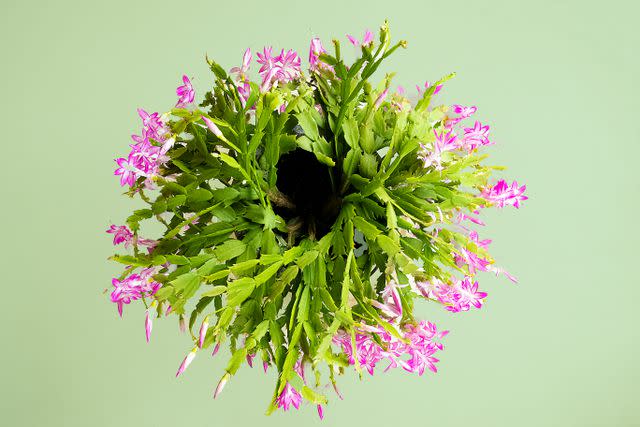How to Propagate a Christmas Cactus Successfully
Get ready to multiply this winter-flowering houseplant.
Arguably one of the best parts of owning a houseplant is the opportunity to turn one plant into many, and rooted cuttings of a favorite plant make a great gift. Though it sounds intimidating, propagation doesn’t have to be stressful, especially when it comes to the Christmas cactus. This winter-blooming, hardy plant is easily multiplied at home—no botany degree or advanced experience required—so this holiday season, all your friends and family can bring a piece of your home into theirs.
Related: How to Choose a Plant for Every Room in Your House

Jerry Hopman/Getty Images
Characteristics
Unlike most cacti, which come from arid, desert climates, the Christmas cactus (or Schlumbergera) actually has origins in the humid and shady areas of southeastern Brazil. It’s actually an epiphytic and epilithic plant, which means it grows on trees and rocks as opposed to the ground. It has leaf-like pads that connect together and trail down, and thanks to the holiday-season bold, vibrant blooms on the tips of its limbs, the Christmas cactus finds itself among pine trees and poinsettias in the category of holiday plants. There are actually three different plants that fall under the category “Christmas cactus,” including the Easter cactus and Thanksgiving cactus, but for simplicity, they’re all interchangeably referred to as a Christmas cactus.
Care
According to plant retailer, The Sill, Christmas cacti need water every 1-2 weeks, allowing the potting soil to dry out at least halfway down in between waterings. These plants also prefer bright to medium indirect light (and don’t handle direct, intense sunlight well), but if you’re looking to increase your chances of lots of winter blooms, The Sill recommends extended periods of lower light in the fall season. They can also benefit from higher humidity in the winter months, so if you want to encourage healthy leaves, try leaving a humidifier near your plant.
Despite not being a desert plant, the Farmer’s Almanac still recommends using a potting soil developed for succulents to pot your Christmas cactus. This type of potting soil is usually a mixture of standard potting soil, coarse sand, and pumice or perlite, as it will provide excellent drainage and prevent your plant from being overwatered.
How to Propagate
There are two different (but equally simple) ways to propagate your cutting: direct planting and water propagation. Direct planting is the most straightforward, as you’ll just stick the cutting directly into potting soil to allow it to root, but water propagation allows you to see the roots growing in real time. Melissa J. Will, gardening expert and blogger behind “The Empress of Dirt,” explains that propagating Christmas cactuses from cuttings is the simplest and easiest method for multiplying your plant.
In order to achieve the best results, Will doesn’t recommend taking cuttings from your plant while it’s budding or in bloom, and slightly warmer temperatures (71-81°F) will help to speed up rooting. You can certainly place more than one cutting into a pot, just allow an inch or so of space between them. Here’s the step by step method:
Pinch a section off of your Christmas cactus at a joint (between two of the leaf segments) instead of cutting. Twisting gently until it breaks free is the easiest method and results in the cleanest cut, and be sure not to break a segment off in the middle. Will recommends taking 1-4 segments at a time for a single cutting, as any more can cause the cutting to topple over in the pot or vessel of water.
For direct planting, place your cutting directly into moist potting soil halfway up the first or second segment, and keep the soil moist while allowing the roots to form.
For water propagation, place the cutting into a small jar, vase, or glass (Will recommends a baby food jar), with the bottom inch of the cutting submerged in water. You can add some rocks in the bottom to help hold the cutting in place, and once the roots are established (at least an inch long), it’s ready to be planted in potting soil.
Related: 9 Best Houseplants for Beginner Plant Parents
For more Real Simple news, make sure to sign up for our newsletter!
Read the original article on Real Simple.

